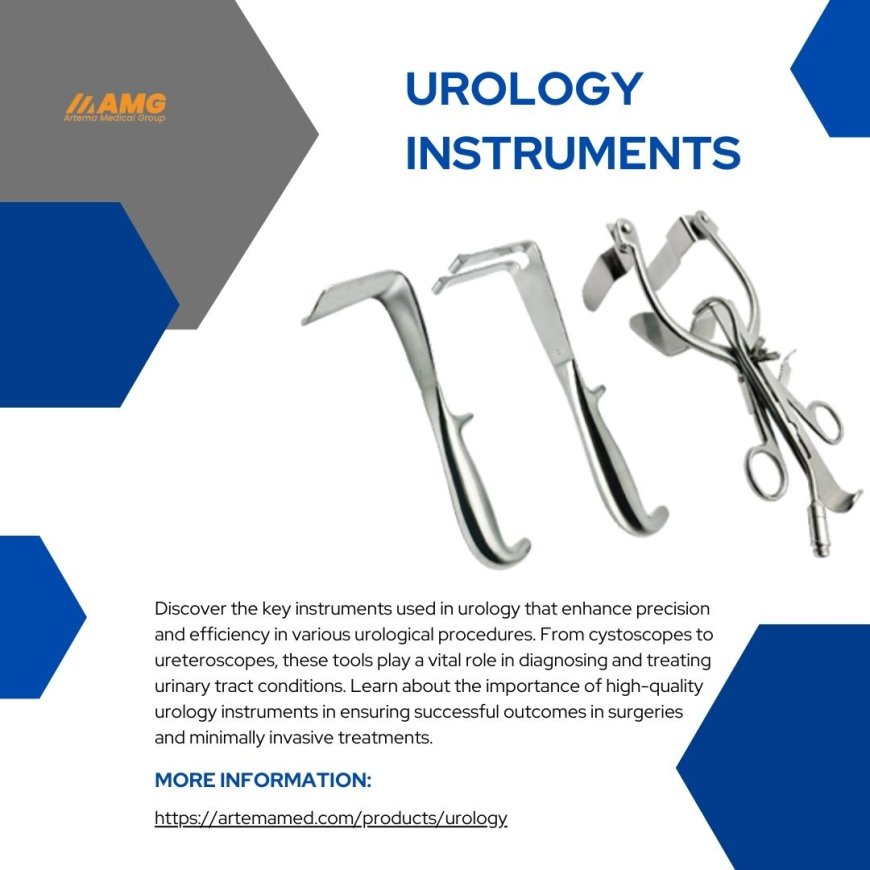How Urology Instruments Work in Modern Medicine
Urology instruments play a pivotal role in modern healthcare, particularly in diagnosing and treating conditions affecting the urinary tract and male reproductive organs.
How Urology Instruments Work in Modern Medicine

These specialized tools allow medical professionals to perform precise, minimally invasive procedures, significantly improving patient outcomes. As technology advances, the range and effectiveness of urology tools have expanded, ensuring that practitioners can address complex urological issues with greater accuracy and care. In this comprehensive article, we will delve into the importance of urology surgical instruments, their applications, and the advancements shaping the future of urological healthcare.
Understanding Urology Instruments
Urology is a branch of medicine that focuses on the diagnosis, treatment, and management of diseases related to the urinary system, including the kidneys, bladder, ureters, and urethra, as well as the male reproductive system. To carry out procedures in this field, urology instruments are meticulously designed for specific purposes, allowing healthcare professionals to approach conditions with precision.
Common urology tools include cystoscopes, resectoscopes, and nephroscopes, which enable the visualization and treatment of the urinary tract. These instruments help in diagnosing conditions such as kidney stones, urinary tract infections (UTIs), prostate cancer, and bladder dysfunction. Each instrument is crafted to optimize functionality while minimizing patient discomfort.
Key Urology Instruments and Their Applications
Cystoscopes
Cystoscopes are one of the most commonly used urology instruments. They are flexible or rigid tubes equipped with a camera that allows the doctor to visually inspect the bladder and urethra. This tool is essential for diagnosing bladder infections, abnormal growths, and urinary blockages.
-
Role: Cystoscopes help in early detection of tumors, polyps, and other anomalies.
-
Advancements: Modern cystoscopes now come with high-definition imaging and smaller diameters, reducing the invasiveness of the procedure.
Ureteroscopes
Ureteroscopes are designed to examine the ureters and the kidneys. These urology surgical instruments are flexible and slender, allowing them to reach even the smallest parts of the urinary system.
-
Role: Ureteroscopes are invaluable in detecting and removing kidney stones, diagnosing cancer in the ureters, and treating blockages.
-
Advancements: With the advent of laser technology, ureteroscopes are now equipped with lasers that help in breaking down kidney stones during the procedure.
Resectoscopes
Used primarily in the treatment of bladder and prostate conditions, resectoscopes are another critical tool in the arsenal of urology instruments. They allow surgeons to remove tissue in a controlled and precise manner.
-
Role: Resectoscopes are essential in procedures such as transurethral resection of the prostate (TURP), which is commonly performed to alleviate symptoms of an enlarged prostate.
-
Advancements: These instruments have seen enhancements such as improved ergonomics and energy sources (electric and laser options), allowing for greater control during surgery.
Nephroscopes
For kidney-related procedures, nephroscopes are among the most crucial urology tools. They are used to visualize and treat conditions within the kidneys, such as stones or tumors, through small incisions.
-
Role: Nephroscopes are often employed in percutaneous nephrolithotomy (PCNL), a procedure to remove kidney stones that are too large to pass on their own.
-
Advancements: Miniaturized nephroscopes with enhanced imaging and irrigation systems have greatly reduced recovery times and complication rates for patients.
The Role of Urology Surgical Instruments in Minimally Invasive Surgery
Minimally invasive surgery (MIS) has transformed the field of urology. Using specialized urology surgical instruments, healthcare providers can perform procedures with smaller incisions, leading to faster recovery times, reduced pain, and fewer complications for patients.
Laparoscopic Urology Instruments
Laparoscopy, commonly referred to as "keyhole surgery," involves using small cameras and instruments to conduct procedures without large incisions. Urology tools used in laparoscopy are designed for precision and flexibility.
-
Applications: Laparoscopic tools are used in procedures like prostatectomy (removal of the prostate), nephrectomy (removal of the kidney), and pyeloplasty (repairing the kidney’s drainage system).
-
Advantages: These instruments minimize trauma to the body, shorten hospital stays, and reduce the risk of infection compared to traditional open surgeries.
Robotic-Assisted Urology Instruments
Robotic-assisted surgery is another revolutionary advancement in the field. By integrating robotic arms with high-definition cameras and specialized urology surgical instruments, surgeons can perform procedures with unprecedented precision.
-
Applications: Robotic-assisted tools are used in complex urological procedures, such as robotic prostatectomies and kidney surgeries.
-
Advantages: These instruments enhance the surgeon’s ability to operate in hard-to-reach areas, offering greater control and flexibility than human hands alone. The precision of robotic systems leads to improved patient outcomes, including less scarring and quicker recovery.
Advancements in Urology Instruments
The evolution of urology instruments has been driven by innovations in medical technology. Over the years, these instruments have become more sophisticated, offering enhanced diagnostic capabilities and greater therapeutic outcomes.
Laser Technology in Urology
Laser technology has revolutionized urology by offering less invasive treatment options. Lasers can be used in a variety of urological procedures, including the treatment of kidney stones, tumors, and benign prostatic hyperplasia (BPH).
-
Benefits: Lasers provide a precise and controlled way to target tissue, reducing bleeding and recovery time for patients. They also enable surgeons to break down kidney stones without the need for traditional surgery.
High-Definition Imaging Systems
Advances in imaging have made urology tools more effective in providing accurate diagnostics. High-definition cameras attached to instruments like cystoscopes and nephroscopes allow for a clearer view of the urinary tract, leading to better diagnosis and treatment planning.
-
Benefits: Enhanced imaging capabilities help surgeons identify even the smallest abnormalities, reducing the chances of missed diagnoses. This technology also aids in better decision-making during surgical procedures.
Why Quality Urology Instruments Matter
The quality and precision of urology surgical instruments directly impact patient outcomes. Inferior instruments can lead to complications, inaccurate diagnoses, or even unsuccessful procedures. As such, healthcare providers invest in high-quality tools to ensure they can deliver the best possible care.
Patient Safety and Comfort
One of the most important considerations in urology is patient safety. High-quality instruments reduce the risk of infections, minimize discomfort, and contribute to quicker recovery times. This is especially critical in procedures involving delicate areas like the urinary tract and reproductive organs.
Long-Term Durability and Reliability
Urology tools are often subjected to sterilization and heavy use. Investing in durable instruments ensures that they remain effective over time, reducing the need for frequent replacements and ensuring reliable performance during procedures.
Conclusion
Urology instruments are indispensable to modern medicine, enabling healthcare providers to diagnose, treat, and manage a wide range of conditions with precision and care. From cystoscopes to robotic-assisted tools, the innovations in this field continue to enhance patient outcomes and push the boundaries of what is possible in urological care. As the demand for minimally invasive surgeries grows, the role of advanced urology surgical instruments will only become more crucial in ensuring efficient, effective, and safe medical interventions.For more detail visit our website Artema medical
What's Your Reaction?



















